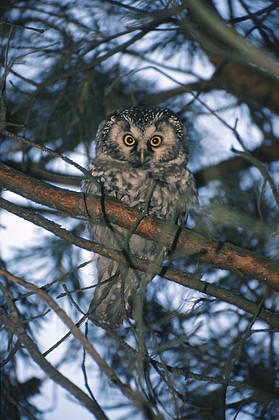Boreal owls heard in calm nights
Photo: Arne Ader
Nature sound: Veljo Runnel
Translation: Liis
Boreal owl.
Boreal owl or Tengmalm's owlKarvasjalg–kakk e laanekakk Aegolius funereus
Boreal owls stay here all year but their number is small. In March-April we meet passing migrants; during that period there may be up to one thousand individuals. The male owls are true to their nesting territories and their territories don’t overlap with the areas of neighbours.
Small owls but distinctly larger than pygmy owls. The owls are misleading when compared to other birds because of the large head but a body maybe the size of a jackdaw, or twenty-five centimetres. First impression of the plumage is dark brown, uppers white-flecked; underparts paler, brown-flecked. Eye-rings pale grey, the eyes themselves yellow. Feet are feathered as the Estonian name, “rough-legged owl“ suggests. Regardless of the small size of the bird, the wing spread is more than half a metre; flight is silent and calm.
As habitat it uses spruce forests as well as mixed forests, pine stands on sand dunes as well as mixed forests at forest river banks. It successfully uses the nest hollows of black woodpeckers and will not surrender them to the owner; it is stronger than the black woodpecker ...
It has nocturnal habits and we see it, and hear the “wooh-wooh-ooh“ calls best in windless periods. They are not sociable birds; the male bird announces its territory to the female. During one or two nights the passing migrants let themselves be heard too, then they move on.









